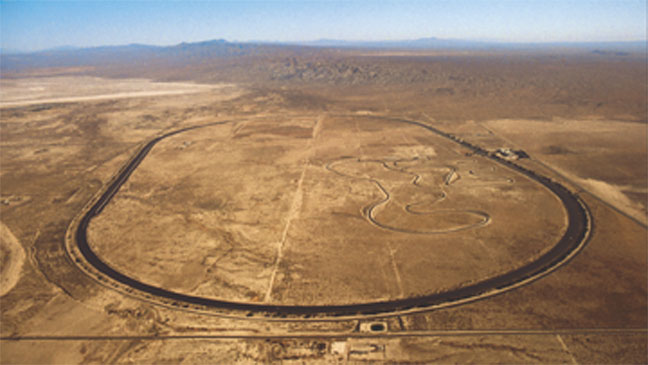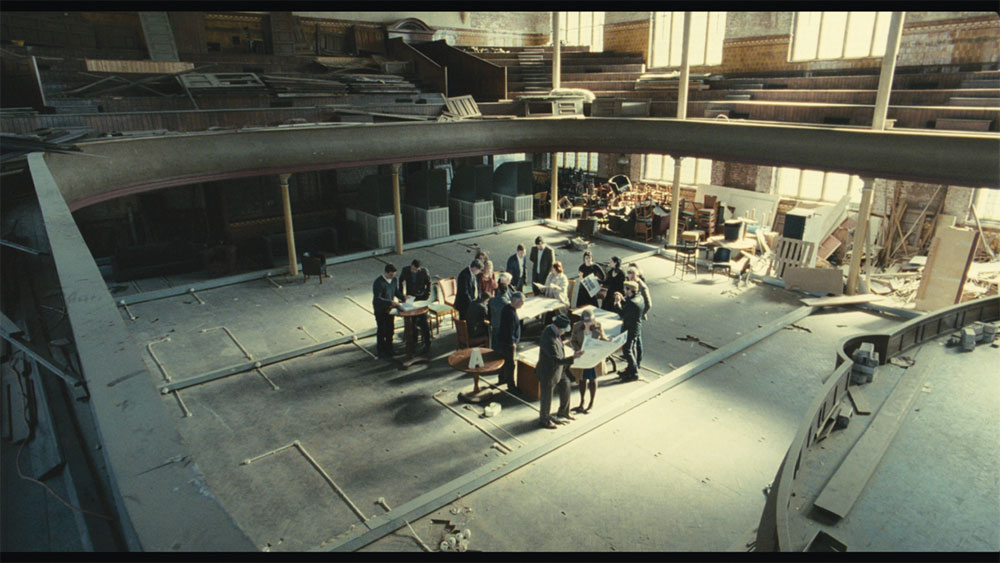« Features
Rosa Barba: Metaphors for History, Time and Society
When the notion of ‘Expanded Cinema’ theorized by Gene Youngblood at the end of the 1960s became a major reference point for a young generation of filmmakers, it didn’t take long to realize that one of the consequences operating in such inter-disciplinary mode was that their work, still intended to be quintessentially defined as ‘film’ would inevitably fall into additional areas like sculpture and performance. In the experimental and adversarial climate of independent filmmaking in the 1970s, however, unforeseen developments of this kind were rather welcome. Aided and abetted by structures that would play an active physical role within the space, filmmakers could now afford to be more adventurous contents-wise, focusing on one, single, strong idea in a fashion not dissimilar from Andy Warhol’s film Empire (1964) or adopting expressive minimal forms like abstraction or repetition.
But if this advent would prove to be a liberating creative experience, from a technical standpoint it ushered in a serious set of limitations. Expensive, occasionally defective and often cumbersome, technology was not in a position yet to match artists’ imaginations, and it wasn’t until the late 1990s, when digital machines supplanted analogical ones, that things started being more viable. Interestingly, at about the same time, a new generation of filmmakers interested in embracing and reviving these antiquated technologies emerged.

Rosa Barba, The Long Road, 2010 (film still), 35-mm film, color, optical sound, 6:14 min. © Rosa Barba.
Rosa Barba (born in Italy; based in Berlin) could certainly be considered part of this group, but unlike many of her peers, her motivation to explore the potentials of the 8-millimeter or 35-millimeter format doesn’t stem from aesthetical or nostalgic reasons. Rather surprisingly, the restrictions that inhibited 1970s filmmakers are one of her principal sources of inspiration. As Barba herself put it, “Film is not the most open medium, but I like the limitations it provides. [...] With Super 8 there was this specific limit in that I was working with light, and it had this performative aspect in that the work would have to be done in three-minute takes. So the cuts with the white came from these limitations. This became my language. I used these cuts to break up the film and also the installation, to work with the space. I don’t know how to work experimentally without something that has limits. Video doesn’t have these limitations so I don’t know how to break with that.”1
Barba’s view of white or empty spaces as an active part of a larger visual narrative is indeed one of the cornerstones of her artistic edification. While it set up a rhythmical movement that contributes to defining time as a tangible entity, with black and white alternating respectively to assume the role of interval and action, it also reflects Barba’s interest in negative spatial dimensions and how they can be functional to the work, as well as a way to chronicle undocumented history. A particular pertinent example of this latter stance is It’s Gonna Happen (2005), a film in which a series of subtitles describing an otherwise invisible landscape are echoed (and rhymed) by the soundtrack of a conversation between a top politician and one of his aides. A clear reference to the so-called “smoking tape” that nailed Richard Nixon at the height of the Watergate scandal in 1974, It’s Gonna Happen underscores the irony of how the gaps, i.e. the non-audible parts, ultimately played a crucial role in the downfall of the President. Similarly, Western Round Table (2009) refers to a mysterious gathering of luminaries such as Marcel Duchamp, Robert Goldwater, Arnold Schoenberg and Frank Lloyd Wright that took place in the Mojave Desert in Southeastern California in 1949. As the exact location of the meeting, as well as what passed in it, is to this day unknown, Barba’s work re-creates an imaginary account of the event by placing one projector in front of another. Faint chimes are heard all around as if to signify a conspiratorial, unintelligible dialogue going on, while the shadows cast on the wall by the running machines suggest an atmosphere of mutual enlightenment. In a time when the most popular platform used to look for historical information is particularly pliable, works like It’s Gonna Happen and Western Round Table come across as a deft warning of the dangers of these easy revisions and omissions. Yet, their undeniable sculptural quality adds an extra layer, representing history as a monument–a towering organism vulnerable to interpretations and misinterpretations but impermeable to intrinsic modifications.

Rosa Barba, Western Round Table, 2007, two 16-mm films, two projectors, two loops, optical sound 2 min, installation view.
Barba’s fascination with blank spaces, when translated to the most figurative side of her filming practice, quite naturally leads to deserts, those huge, desolate, timeless sceneries where some of the most daring ideas humankind has ever conceived have been tested and occasionally implemented. “I am fascinated with vast, arid landscapes, as they seem to preserve documents in a much more intense way,” Barba said on the occasion of her solo exhibition at the Kunsthaus Zürich in 2012.2 Works like The Long Road (2010), an aerial view of an abandoned oval racetrack, or Time as Perspective (2012), a journey through the drilling machines that regularly pump oil out of Texas soil, possess a degree of geological analysis that would make The Center for Land Use Interpretation proud.3 Both pieces present obvious Land Art correlations, but whereas The Long Road captures a still, decrepit presence, which despite its alien status now results in a surprisingly integrated bit of the landscape, Time as Perspective paints a much more disconcerting picture. The immensity of the area in which the action takes place, and the machines’ constant mechanical movements, act as a metaphor for a Fritz Lang-like sinister industriousness. Their connection with the ground that hosts them is brutal, almost parasitical, and the absence of any trace of human existence evokes a futuristic scenario filtered through a grained 35-millimeter sensibility–a juggle between past, present and future that hints of the methodology often adopted by science-fiction writers (the conjecture of hypothetical future storylines by projecting occurrences from the past), and that fully explains the meaning of the title.

Rosa Barba, Coro Spezzato: The Future Lasts One Day, 2009, five 16mm color films, five modified projectors on pedestals, 5 min each. Installation at Cornerhouse, Manchester, UK, 2013. Photo: We Are Tape.
Barba’s outing in the U.K. in 2013, with the double solo exhibition “Subject to Constant Change” at Turner Contemporary in Margate and Cornerhouse in Manchester, introduced new elements to her temporal and sociological investigation. The centerpiece of both shows, Subconscious Society (2013), is a film designed to establish a critical relationship with the sites in which it was made. If the segment filmed in Margate somehow reprises the same ideas expressed in Time as Perspective and The Long Track, mainly focusing on the stranded ships and falling piers that disfigure a once lively coastal town to illustrate the definitive demise of the 20th-century industrial age, the one realized in Manchester takes a significant leap. It features actual people (a very rare occurrence in Barba’s film work) in the shape of a group of residents interacting with the now abandoned Wesleyan chapel at Albert Hall on Peter Street. Moving around the building in a liberally choreographed manner, the characters in question appear to be suspended in a transitional dimension, caught between the imminent advent of the digital era and the passing away of an older, more reassuring age they seem willing to preserve. Their movements are at times poetic, desperate or futile and range from toying with a majestic but silent pipe organ to trying to interact with a string of obsolete devices dispersed across the room. A strange aura permeates these objects. They look familiar but not totally identifiable, and the inability to successfully activate them leaves the company with a feeling of resignation. Even in its most dry moments, Barba’s work is never fully acritical–what she does amounts more to research than observation–but rarely before has conceded so much to romanticism, and the fact that she decided to work with members of a tight-knit community further underscores the general sense of melancholy.
Time-related issues were also prominent in another piece in the show, Coro Spezzato: The Future Lasts One Day (2009), an installation composed of five 16-millimeter projectors based on the idea of the early-Baroque Venetian polychorus, where singers are split into two factions and chant at alternate times leaving gaps in between. Programmed to follow the choirmaster in the form of text projected on a large screen, the projectors generate a multitude of sounds. Musicians are generally renewed for having invented highly developed and differentiated ways of dealing with time. Coro Spezzato: The Future Lasts One Day, like every work of polyphonic music, is a representation of how a group of people can inhabit time together. But is it a relationship of equity of dominance? The fragmented nature of the piece doesn’t provide an answer, but its performing quality was successfully reemployed in Subconscious Society - Live (2013), Barba’s commission in Performa 13, a semi-performative piece in which a similar social group entrapped in a provisional time metaphorically tries to archive the past in the hope of achieving a more legible present.
NOTES
1. See Gil Leung, “White is an Image: Rosa Barba in conversation with Gil Leung,” Lux Artists’ Moving Image, London, 2010, www.lux.org.uk.
2. See “Rosa Barba in conversation with Miriam Varadinis and Solveif Øvstebø,” Kunsthaus Zurich and Bergen Kunsthall, 2012.
3. A research and education organization founded in California in 1994 dedicated to the study and comprehension of human interaction with the earth’s surface; www.clui.org.
Michele Robecchi is a writer and curator based in London. Former managing editor of Flash Art (2001-2004) and senior editor at Contemporary Magazine (2005-2007), he is currently a visiting lecturer at Christie’s Education and an editor at Phaidon Press, where he edited monographs on Marina Abramovic, Francis Alÿs, Jorge Pardo, Stephen Shore and Ai Weiwei.






































Leave a Reply
You must be logged in to post a comment.